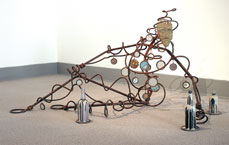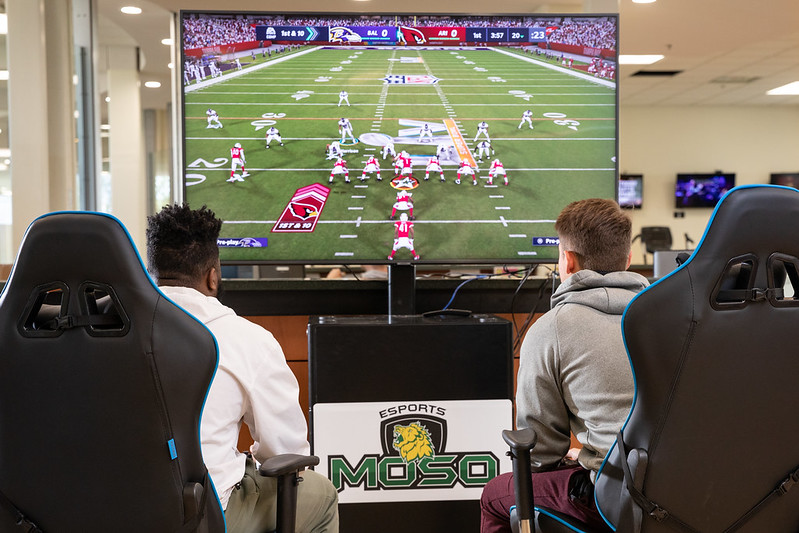Garage sale garbage garners artist attention

Rhett Johnson, local artist, uses rejected everyday objects to give his sculptures life, like his “Marooned Figure” created from metal rebar.
In their skilled hands, ironing boards become dragons, doorknobs become feet and items like scissors, buttons and glass bottles show more diversity than ever before.
The current exhibit at George A. Spiva Center for the Arts, “A Confederacy of Objects: Art from Odds and Ends,” demonstrates the adage “one man’s trash is another man’s treasure.”
Four artists participate in the assemblage art showcase taking everyday, rejected objects and incorporating them in unconventional ways to create sculptural masterpieces.
“I’ve heard it called the art of ‘juxtaposed stuff,'” said Jo Mueller, Spiva’s executive director. “There are many people doing that (assemblage art) right now, and it’s not confined to the United States at all.”
One of the artists exhibiting, Roger Hines, a Tulsa native now residing in New York City, won first place in the 2003 Berlin International Assemblage Artists Exhibition with his work now being displayed at Spiva, “Rooms of the Mind #12.”
Hines’s works consist of molding and edging of old houses, chair legs and picture frames that create a box or “room” encased with glass. In these rooms are dismembered antique glass dolls with mechanical bodies floating against a backdrop of starry fabric. The images are saturated with small mechanical pieces and antique watch faces crawling up the sides of the rooms. Hines works almost exclusively with found materials to leave the viewer with the eerie feeling walking through an abandoned gothic mansion.
Hines explains the idea behind his “Rooms of the Mind” series in a written philosophy.
“Our mind is like a mansion that contains millions of ‘rooms,’ each one, a compilation described by our thoughts, dreams, emotions, ecstasies, angers and secrets of our deepest selves,” Hines said. “There is so much that remains unseen. Until we unlock the door and look inside.”
Judy Onofrio, from Minnesota, creates her vibrant, colorful, almost Latin American style pieces by carving figures of wood, then covering them with grout and decorating with glossy paint and small jewels and glass she found in various places. The results are ornate sculptures that seem reminiscent of Carmen Miranda in a dream sequence, holding bananas or fish.
“She (Onofrio) says she’s been collecting junk all of her life,” Mueller said.
Marve Dahmen, a Carl Junction artist, gives a showing with a large body of works displayed, all of which he created since January.
“He is a very prolific artist,” Mueller said. “He seeks out things and goes to a lot of garage sales.”
Dahmen’s series of works, “Variations in Brass and Copper,” incorporates resin thickly painted or dripped on the canvas along with old parts of antique scales and other small mechanical items like computer keys, all painted in layers of gold, silver and bronze. A favorite of Dahmen’s works among viewers is “I’m Always on the Lookout for a Better Glue” because the mound of machine parts on the canvas appears to be dropping pieces onto the ground, actually taking the artwork past the canvas.
More space in the exhibit is dedicated to local artist Rhett Johnson from Dearborn, Mo. In the last several years, Johnson has excavated more than 300 old outhouse sites in Platt and Buchanan counties trying to uncover objects that still have something to say. The nature of his findings has undoubtedly influenced his works, which bear a strong Native American influence. Other times Johnson spends whole days visiting rummage sales trying to scrounge up something useful or interesting – a potential wing or tooth.
Johnson’s most impressive piece is a tribute to the men and women who died in the 9-11 terrorist attacks. The piece is a life-sized body lying in the mummy position, wrapped with cloth and an American flag. Small, everyday artifacts and baubles decorate the body and are tied down with leather strings that hang to the ground. A tailor’s measuring tape is wound around the body in such a way the nines and the 11s intersect.
The entire exhibit is a change of pace for Spiva a welcome one according to Mueller .
“It’s very exciting,” she said. “It induces a lot of smiles because it’s very playful. You see things that might just look like a bunch of junk to you, and they pick it up, and then they put it with everything else into something amazing.”
The exhibit runs through Sunday. Spiva’s hours are 10 a.m.-5 p.m. Monday-Saturday and 1-5 p.m. Sunday. For information call 623-0183.
Your donation will support the student journalists of Missouri Southern State University. Your contribution will allow us to purchase equipment and cover our annual website hosting costs.















